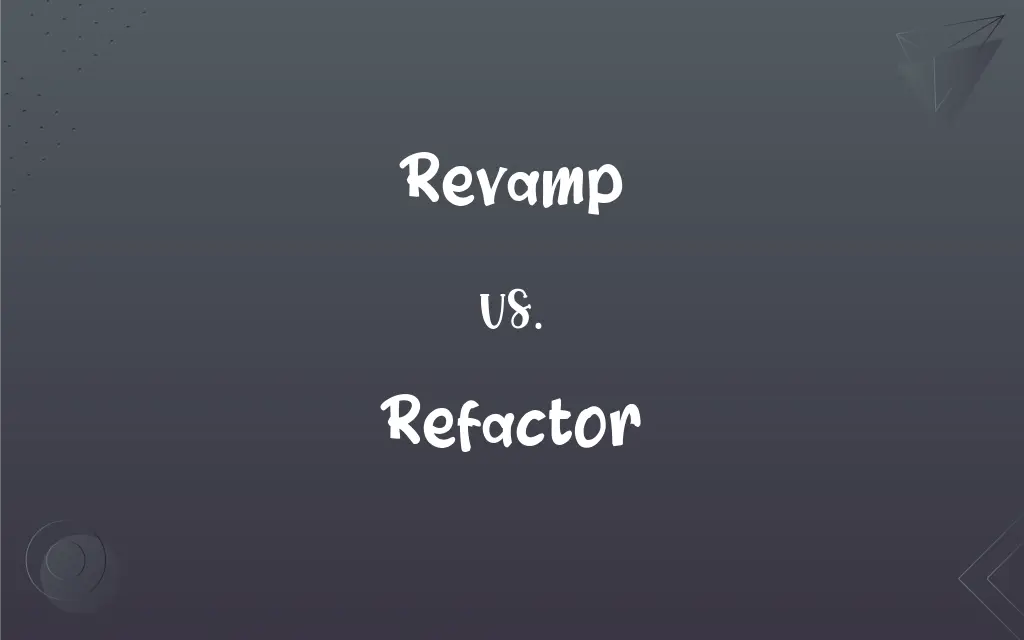Revamp vs. Refactor: What's the Difference?
By Harlon Moss & Aimie Carlson || Updated on May 23, 2024
Revamp involves overhauling or updating something's appearance or function, while refactor focuses on restructuring internal code without changing external behavior.

Key Differences
Revamp involves making significant changes to improve something's appearance or functionality. This can include redesigning interfaces, adding new features, or updating outdated systems to make them more appealing or efficient. It often has a noticeable impact on the end-users. Refactor, on the other hand, focuses on improving the internal structure of code without altering its external behavior. This process aims to enhance code readability, maintainability, and performance. Unlike revamping, refactoring is mostly invisible to end-users but crucial for long-term software health.
When revamping a software application, developers might redesign the user interface or add new functionalities to attract and retain users. This process often involves visible changes that users can immediately notice and appreciate. While refactoring, developers work behind the scenes to clean up and optimize the codebase. This ensures that the software runs more efficiently and is easier to maintain, even though the end-user experience remains unchanged.
Revamping can sometimes include elements of refactoring if the internal code structure needs improvement to support new features or updates. However, the primary focus remains on outward-facing changes. Refactoring strictly pertains to internal code improvements. Developers refactor to reduce technical debt and enhance the code's structure, making it more robust and less prone to errors.
Comparison Chart
Focus
External appearance/functionality
Internal code structure
Impact on Users
Visible changes
Invisible changes
ADVERTISEMENT
Primary Goal
Improve aesthetics/utility
Improve code readability/maintainability
Process Involves
Redesign, adding new features
Code optimization, cleaning
Time Frame
Typically longer, more extensive
Generally shorter, incremental
Revamp and Refactor Definitions
Revamp
To overhaul completely.
They plan to revamp the marketing strategy to boost sales.
Refactor
To restructure existing computer code without changing its external behavior.
The team decided to refactor the code to improve performance.
ADVERTISEMENT
Revamp
To improve the design or structure.
The product line was revamped to meet the latest trends.
Refactor
To improve the internal structure of the code.
Developers refactored the legacy codebase to make it more maintainable.
Revamp
To renovate or update for improved appearance or functionality.
The company decided to revamp its website to attract more visitors.
Refactor
To optimize software to enhance readability and efficiency.
The project involved refactoring several functions for better clarity.
Revamp
To give a new and improved form, structure, or appearance to.
The kitchen was revamped with modern appliances and new cabinets.
Refactor
To make code cleaner and more efficient.
Refactoring the module reduced the system's load time.
Revamp
To patch up or restore; renovate.
Refactor
To reorganize the code to reduce complexity.
Refactoring helped eliminate redundant code and simplify the system.
Revamp
To revise or reconstruct (a manuscript, for example).
Refactor
(computer programming) To rewrite existing source code in order to improve its readability, reusability or structure without affecting its meaning or behaviour.
The code works, but I must refactor it before it is production quality.
Revamp
To vamp (a shoe) anew.
Refactor
(writing) To rewrite existing text in order to improve its readability, reusability or structure without intentionally affecting its meaning. Similar to, but sometimes involving more extensive restructuring than, copy editing.
Two significant activities which to contribute to community projects, such as Wikipedia, are to refactor complicated articles into simpler ones, and to refactor duplicated content into reusable templates.
Revamp
The act or an instance of revamping; a complete reorganization or revision.
Refactor
(computer programming) The process by which source code is refactored.
We don't have time for a major refactor: we're shipping in two weeks.
Revamp
(transitive) To improve, renew, renovate, or revise (something).
They plan to revamp the historical theater in the old downtown.
Revamp
An act of improving, renewing, renovating, or revising something; an improvement, renovation, revamping, or revision.
A revamp of a website
Revamp
To vamp again; hence, to patch up; to reconstruct.
Revamp
To patch up or renovate; repair or restore;
They revamped their old house before selling it
Revamp
Provide (a shoe) with a new vamp;
Revamp my old boots
Revamp
To change or arrange something to make it more effective.
The revamp of the organizational chart streamlined communication.
FAQs
Can revamping include refactoring?
Yes, revamping can include refactoring if internal code improvements are needed to support new features.
What is refactoring in coding?
Refactoring involves restructuring existing code without changing its external behavior.
How does revamping affect users?
Revamping leads to visible changes and enhancements that users can see and experience.
Is refactoring only for old code?
No, refactoring can be applied to both new and existing code to improve quality.
What is a revamp?
A revamp is a major update or overhaul to improve appearance or functionality.
How often should you revamp a website?
It depends on user needs and technological advancements, but generally every few years.
Is refactoring the same as rewriting code?
No, refactoring modifies the structure of existing code, whereas rewriting replaces it entirely.
Does revamping require new design elements?
Often, yes. Revamping usually involves new design elements to refresh the look and feel.
Can refactoring lead to new bugs?
While possible, proper testing during refactoring minimizes the risk of new bugs.
Does refactoring change the software's functionality?
No, refactoring improves the code's internal structure without altering its functionality.
Is refactoring time-consuming?
Refactoring can be time-consuming, but it's essential for long-term code health.
Why is revamping important?
Revamping is important to keep software or products updated, user-friendly, and competitive.
What are the benefits of refactoring?
Benefits of refactoring include better code readability, maintainability, and performance.
What skills are needed for revamping?
Skills needed for revamping include design, development, and user experience expertise.
Can revamping increase user engagement?
Yes, a successful revamp can significantly increase user engagement and satisfaction.
Does revamping always involve major changes?
Not always, but it typically involves significant updates rather than minor tweaks.
Is refactoring part of regular maintenance?
Yes, refactoring is a crucial part of regular code maintenance and improvement.
Does refactoring improve code security?
It can, by removing vulnerabilities and improving overall code quality.
How do you identify code that needs refactoring?
Code that is difficult to read, maintain, or extend is a good candidate for refactoring.
What is a common sign that a revamp is needed?
Decreased user engagement or outdated design often signals the need for a revamp.
About Author
Written by
Harlon MossHarlon is a seasoned quality moderator and accomplished content writer for Difference Wiki. An alumnus of the prestigious University of California, he earned his degree in Computer Science. Leveraging his academic background, Harlon brings a meticulous and informed perspective to his work, ensuring content accuracy and excellence.
Co-written by
Aimie CarlsonAimie Carlson, holding a master's degree in English literature, is a fervent English language enthusiast. She lends her writing talents to Difference Wiki, a prominent website that specializes in comparisons, offering readers insightful analyses that both captivate and inform.































































